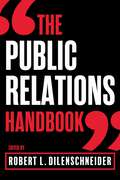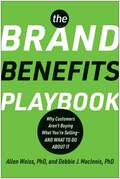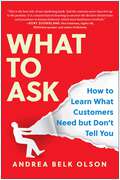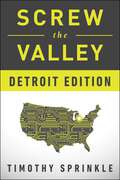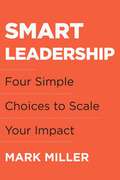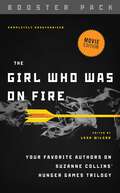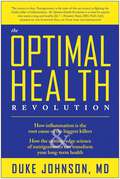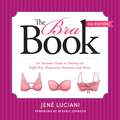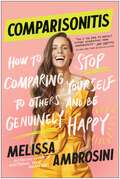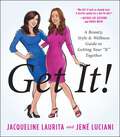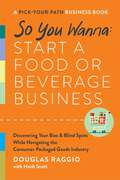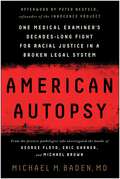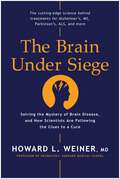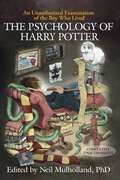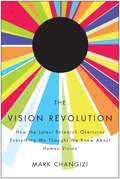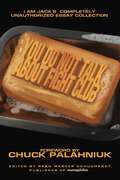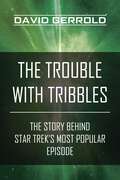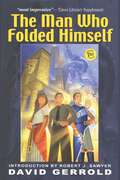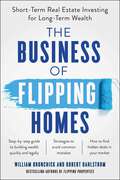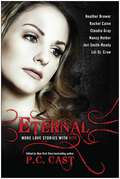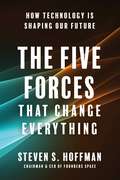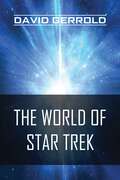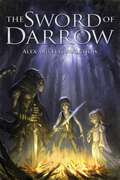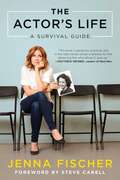- Table View
- List View
The Public Relations Handbook
by Robert L. DilenschneiderTo be a successful public relations professional, it&’s no longer enough to be great at writing press releases and establishing media contacts. You must also expertly navigate the digital world and be prepared to dovetail your skills with those of other professionals. The Public Relations Handbook is a comprehensive and invaluable guide for public relations practitioners in the 2020s and beyond, covering the multitude of skills needed in the current environment, including: Supporting a company&’s marketing and sales Leveraging social media Managing government relations Working with the media effectively Communicating with the investment community Supporting top management in the event of a crisis or scandal Positively positioning the company&’s commitment to environmental, social, and governance issues The Public Relations Handbook has been an indispensable guide for public relations professionals since the first edition was published in 1967. This new fifth edition explains how to navigate a far more complex and constantly changing digital world while facing new challenges in financial, economic, political, public health, and societal issues. Editor Robert L. Dilenschneider is a communications executive who has called on leading practitioners in the field to address the specific skill sets, strategies, and execution that public relations practitioners need today. The scope of public relations is always expanding. Today&’s professionals must be prepared to deal with a wide variety of people, issues, and topics. The Public Relations Handbook will help all practitioners in the field advance their personal growth, success and careers.
The Brand Benefits Playbook: Why Customers Aren't Buying What You're Selling--And What to Do About It
by Allen Weiss Deborah J. MacInnis2024 Global Book Awards Finalist From two of the world&’s leading experts on branding, brand benefits, and positioning, this strategic guide reveals how focusing on brand benefits can transform organizations and help them win in the marketplace. Today&’s customers think less about products and more about brands, no matter whether those brands are organizational, nonprofit, individuals, or service oriented. Customers also care less about the features of your product—what it has—than about its benefits—what it does for them. While this sounds like common sense, shockingly few organizations actually conduct business this way. Drs. Allen Weiss and Debbie J. MacInnis, professors and branding, brand benefits, and positioning experts, are about to change that. In The Brand Benefits Playbook, Weiss and MacInnis help readers understand, and transition to, a benefits-based model. This focus on customer benefits will teach organizations: What market they are in (or could be operating in) How customers perceive their brand (and that of their competitors) in terms of benefits The most effective way to segment a market and position a brand in terms of benefits How to deliver benefits throughout the customer journey How a focus on benefits facilitates growth Evidence-based, integrated, and simple, this innovative approach can be applied to all markets—and ensures that any brand can deliver the benefits its customers truly want.
What to Ask: How to Learn What Customers Need but Don't Tell You
by Andrea Belk OlsonDoes capturing customer feedback feel like a pointless exercise? No matter the number of surveys, interviews, or studies conducted, we regularly fail to uncover those gems needed to make our organization stand out. It&’s no surprise given that &“expert&” guidance states the obvious, like &“Ask open-ended questions,&” &“Identify patterns,&” or &“Extract insights.&” What&’s needed is a way to discover what we&’re missing. Traditional customer feedback methods ignore two essential sources of insight: context and behavior. These reveal the WHY behind the WHAT, eliminating the ambiguity of open-ended customer feedback—and this requires a different approach. In What to Ask, author Andrea Belk Olson, CEO of applied behavioral science consulting firm Pragmadik, and head of the University of Iowa JPEC startup incubator, delivers a unique, cognitive method for discovering hidden customer needs, converting them quickly into differentiators, and avoiding the pitfalls of traditional research. Olson also details how individuals and organizations can better tune into customer needs by sharpening their strategic focus, cultivating customer-focused behaviors, and challenging cognitive biases. For anyone faced with discovering what customers really want, What to Ask delivers a concise approach for spotting those unspoken customer needs and converting them into real customer innovations.
Screw the Valley: Detroit Edition
by Timothy SprinkleIt's time to put the Valley in your rearview mirror. Destination: New Startup America. Next stop: Detroit. In this companion eBook to Screw the Valley, Timothy Sprinkle highlights Detroit, one of seven cities that offers superior landscapes for tech startups. With brand new, city-specific content, an excerpt from Screw the Valley, and a compilation of the dynamic assets and support available to local startup founders and tech advocates, Screw the Valley: Detroit Edition gives readers a glimpse into the startup potential of "Motor City" and the unique resources it has to offer. Bright ideas are not geographically limited, and innovation is happening every day in cities all over the country. It's time to think outside the box when it comes to startup location. It's time to say Screw the Valley.
Smart Leadership: Four Simple Choices to Scale Your Impact
by Mark MillerEscape the mediocrity that ensnares so many in business and become a better, more effective leader. Have you ever wondered what it would take to be a better leader, or achieve your wildest dreams, or make a bigger difference in the world? The answer lies in the choices you make: about everything from how you spend your time to the way you view the world. Smart Leadership is the latest essential business title from internationally bestselling author of Win the Heart and Chess Not Checkers Mark Miller. In this book, he shares the four research-based &“smart choices&” the best leaders make to scale their influence and results. By teaching you how to Confront Reality, Grow Capacity, Fuel Curiosity, and Create Change, Miller will help you: Bring fresh eyes and fresh thinking to your leadership approach. Increase your confidence in your ability to make a difference. Lead at levels you never thought possible. Accelerate your learning curve so that all these benefits come faster and more naturally. With this guide, your leadership—and your life—will be transformed forever.
The Girl Who Was on Fire - Booster Pack: Your Favorite Authors on Suzanne Collins' Hunger Games Trilogy
by Brent Hartinger Diana PeterfreundThis e-book only Booster Pack is designed for readers who have read the first edition of The Girl Who Was on Fire. The Booster Pack includes ONLY the three brand new essays included in The Girl Who Was on Fire - Movie Edition, plus access to 10,000 words of extra, e-book only content: the contributors' thoughts on the Hunger Games film. The first edition of The Girl Who Was on Fire offered even more to think about for readers already engrossed by the world of the Hunger Games. From the trilogy's darker themes of violence and social control to reality television, fashion and weaponry, the collection's exploration of the Hunger Games by other YA writers revealed exactly how rich, and how perilous, protagonist Katniss' world really is. These three new essays discuss game theory in the Hunger Games, mixed opinions about Mockingjay, and why we shouldn't forget about Gale, just because Katniss chose Peeta. This e-book also gives you access to special content from our writers right after the release of The Hunger Games on the big screen: their thoughts on the film.
The Optimal Health Revolution: How Inflammation Is the Root Cause of the Biggest Killers and How the Cutting-Edge Science of Nutrigenomics Can Transform Your Long-term Health
by Duke JohnsonCutting-edge science is coming to a startling realization. The bulk of our most lethal diseases have a common underlying cause: persistent inflammation, an over-active reaction of our natural immune system function resulting in cell and tissue destruction. This persistent inflammation is triggered by our industrial lifestyles, including exposure to chemicals, synthetic food ingredients, pollution and processed foods. "Researchers are linking inflammation to an ever-wider array of chronic illnesses," reports Newsweek's Anne Underwood. "Suddenly medical puzzles seem to be fitting together, such as why hypertension puts patients at increased risk of Alzheimer's, or why rheumatoid-arthritis sufferers have higher rates of sudden cardiac death. They're all connected on some fundamental level." But inflammation, and the risks of chronic diseases it brings, can be managed. Lifestyle and nutritional change is part of the answer. But the other part of the answer lies with ground-breaking information from the newest field of science—nutrigenomics. Nutrigenomics is the science of how your genes interact with nutrients. It is the study of how DNA and the genetic code affect a person's need for certain nutrients and help maintain optimal health throughout life. The Optimal Health Revolution combines leading-edge science — including 600 scientific references — with an easy to read, conversational writing style that make this critical information accessible to every reader. Relevant to both the researcher and medical doctor interested in the latest science and the casual reader looking to improve his or her health, The Optimal Health Revolution makes a critical contribution to our understanding of health.
The Bra Book: An Intimate Guide to Finding the Right Bra, Shapewear, Swimsuit, and More!
by Jené LucianiIt's time to have FUN finding the perfect fit—fashion expert Jené Luciani is here to help. In 2009, The Bra Book helped countless women find the right bra. Now, Luciani, known as "Dr. Oz's Bra Guru," returns with this updated edition of her one-and-only guide to all things underneath. If 85 percent of women are wearing the wrong bra, what else in their undergarment drawers doesn't fit as well as it could? Luciani continues her mission to arm women with the knowledge they need to find the right fashion support. From the best bra for every outfit to important information about bras and breast health from puberty to retirement, from the physics behind bra design to how you can best ensure a proper fit, The Bra Book: Second Edition is still the ultimate resource on bras for women everywhere. Lucky for us, Jene has expanded the book to include new and updated, yet essential, information from the ever-changing world of intimate apparel. In the era of "smooth is better," thanks in part to the "Spanx movement," The Bra Book: Second Edition now features a guide to the often overwhelming world of shapewear and swimsuits. Luciani eliminates confusion with her friendly guidance on finding the perfect fit and even tackles the uncomfortable questions, such as, "What really causes sagging?" Discover new ways to best flatter your figure—and have fun shopping for that perfect fit. The Bra Book: Second Edition doesn't just tell women how bras and shapewear work; it shows them how to make those garments work for them!
Comparisonitis: How to Stop Comparing Yourself To Others and Be Genuinely Happy
by Melissa AmbrosiniMultiple bestselling author Melissa Ambrosini (Mastering Your Mean Girl, Open Wide, PurposeFULL) and host of the #1 podcast The Melissa Ambrosini Show puts the condition of Comparisonitis under the microscope, unpacking the symptoms, and offering practical tips you can start using immediately to break the cycle of comparison, free up mental bandwidth, and live life on your own terms. When you cure Comparisonitis, you will… Be free to live your life for you (no one else) Feel peace from within Experience genuine happiness Truly appreciate your body and life Free up SO much mental bandwidth for things you LOVE Quit beating yourself up Have more energy to go after the things that truly matter to you Experience a radical shift towards authenticity Be a better friend, partner, parent, family member, colleague, human Free yourself from expectations Unleash the courage to go after your dreams Unstifle your creativity Feel more liberated than you've ever felt in your life And much more It creeps up on you without warning—perhaps while chatting with a friend, scrolling through social media, or even just while walking down the street. All it takes is the hint of someone doing or having something you perceive as "better" than you, and it hits. A feeling takes over—intense, blinding, gutting. Your brain starts spinning with toxic thoughts about yourself (or others), and you're left feeling ashamed, guilty, and even worthless. It's called comparisonitis. And if you've suffered from it, you're NOT alone. Comparisonitis is a contagious, socially transmitted condition that occurs when you compare yourself to others so frequently and fiercely that you're left paralyzed, with your confidence in tatters and your self-worth plummeting. It may sound trivial, but this affliction can have serious adverse effects on our mental health, leading to depression, anxiety, overthinking, and regret. To make matters worse, our comparison culture is only expanding. Thanks to social media, we have more opportunities to compare ourselves than ever before, and even kids are falling into the trap. Described as a "self-help guru" by Elle magazine, Melissa has experienced the effects of comparisonitis first hand, having worked extensively in industries like acting, modeling and dancing where comparison culture is not only rampant but openly encouraged. Melissa knows all too well how comparisonitis is infecting our minds and hurting our hearts, and in this book, she'll help you heal from this disease, liberate your headspace, and raise your self-worth so radically that you'll never let comparison rob you of your joy and happiness again.
Get It!: A Beauty, Style, and Wellness Guide to Getting Your "It" Together
by Jacqueline Laurita Jené LucianiHey, gorgeous! You know how you're always thinking about getting more organized? More focused? Healthier? Changing up your hair routine? And so many other things? It's time to stop thinking about it and do it! We know getting started seems overwhelming; we've been there. We're both busy professionals and moms, so we know how self-care gets pushed to the side. But that's not the way it should be! We want to help you become your best self—that's why we teamed up to write Get It! And gathered all our favorite tips, tricks, and secrets to help you get whatever "it" you want: Get Centered, Get on Track, Get Organized, Get Healthy, Get Fit, Get Beautiful Hair, Get Flawless Skin, Get Made Up, Get Stylish and Sexy—in just minutes a day. From finding a calm center amidst chaos and dressing for your body type in your 30s, 40s, and beyond, to getting in shape no matter what your schedule looks like and saving time on hair, makeup, and looking and feeling young, Get It! is the ultimate handbook to finding style, beauty, and wellness within yourself while getting exactly what you want out of life. We're so excited to share this book with you. Whatever you want—it's time to get it! XOXO, Jacqueline and Jené
So You Wanna: A Pick-Your-Path Business Book
by Douglas RaggioA pick-your-own-path guide to launching and sustaining a successful food or beverage business The specialty food and beverage business is a thriving industry, and the barriers to entry are low: all you need is a recipe idea and a place to make it. It sounds simple, but launching a food or beverage company is a maze of choices and consequences. Douglas Raggio has been there, both as a food business founder and as a consultant to other successful start-ups, and he&’s come to learn that every choice a food founder makes has a fairly predictable outcome. In So You Wanna: Start a Food or Beverage Business, he helps you think through the many decisions you&’ll make along the road from idea to success—whether you see yourself building a following at your farmer&’s market, partnering with a local restaurant, or launching the next Pepsi. This innovative guide follows four archetypal food start-ups that cover a range of business ideas and founders. Every few pages, you&’ll make crucial decisions about the next step to take in growing a hypothetical business. You&’ll have a chance to see how each choice is likely to play out before you try out anything in the real world, where the stakes are higher. In this book, you&’ll see the maze of choices and outcomes that go into: Coming up with an exciting, profitable new product Funding your start-up Conducting market research Pricing and producing to scale Establishing partnerships, promotions, and branding Deciding when to keep going—and when to fold By understanding the perils and pleasures of this fast-growing industry, you will be able to approach your own business with confidence, make the decisions that feel right to you, and avoid the most common pitfalls along the way.
American Autopsy: One Medical Examiner's Decades-Long Fight for Racial Justice in a Broken Legal System
by Michael M. BadenA revealing history of covering up the true causes of deaths of BIPOC in custody—from the forensic pathologist whose work changed the course of the George Floyd, Eric Garner, and Michael Brown cases Dr. Michael Baden has been involved in some of the most high-profile civil rights and police brutality cases in US history, from the government&’s 1976 re-investigation of the assassination of Martin Luther King, Jr., to the 2014 death of Michael Brown, whose case sparked the initial Ferguson protests that grew into the Black Lives Matter movement. The playbook hasn&’t changed since 1979, when Dr. Baden was demoted from his job as New York City&’s Chief Medical Examiner after ruling that the death of a Black man in police custody was a homicide. So in 2020 when the Floyd family, wary of the same system that oversaw George Floyd&’s death, needed a second opinion—Dr. Baden is who they called. In these pages, Dr. Baden chronicles his six decades on the front lines of the fight for accountability within the legal system—including the long history of medical examiners of using a controversial syndrome called excited delirium (a term that shows up in the pathology report for George Floyd) to explain away the deaths of BIPOC restrained by police. In the process, he brings to life the political issues that go on in the wake of often unrecorded fatal police encounters and the standoff between law enforcement and those they are sworn to protect. Full of behind-the-scenes drama and surprising revelations, American Autopsy is an invigorating—and enraging—read that is both timely and crucial for this turning point in our nation&’s history.
The Brain Under Siege: Solving the Mystery of Brain Disease, and How Scientists are Following the Clues to a Cure
by Howard L. Weiner1 in 6 people suffer from brain diseases like MS, Parkinson&’s, and Alzheimer&’s. Now, a Harvard neurologist takes you inside the brain under attack—and illuminates the path to a cure. Multiple Sclerosis. Parkinson&’s Disease. Alzheimer&’s. ALS. Chances are, you know someone with a neurologic disease. Because the brain controls so much and is integral to our identity, the diseases that affect it are uniquely devastating both to patients and families. And because it remains the most mysterious of our vital organs, treating the brain is an ongoing puzzle. In The Brain Under Siege, Howard Weiner likens the brain to a crime scene, showing readers how &“clues&” point to causes and suggest paths to a cure. He takes readers on a journey through the latest technological advances, exploring which routes of investigation have gone cold and which have led to breakthroughs. Readers couldn&’t ask for a better guide: A professor of neurology at Harvard Medical School and co-director of the Ann Romney Center for Neurologic diseases, Weiner is an internationally renowned expert, who pioneered immunotherapy in MS and is currently investigating an Alzheimer&’s vaccine. Informative and engaging, this groundbreaking book tells the story behind the science—painting a picture of the discoveries, setbacks, false leads, and victories on the front lines of brain research. Weiner also offers unique insight by exploring the experiences of the brave patients and families who make cutting-edge clinical trials possible. Both a clear-eyed assessment of where the science stands and a gripping and poignant narrative of the dramatic pursuit for a cure, The Brain Under Siege is a must-read for patients, families, and anyone interested in unraveling the mysteries of the brain.
The Psychology of Harry Potter: An Unauthorized Examination Of The Boy Who Lived
by Neil MulhollandHarry Potter has provided a portal to the wizarding world for millions of readers, but an examination of Harry, his friends and his enemies will take us on yet another journey: through the psyche of the Muggle (and wizard!) mind. The twists and turns of the series, as well as the psychological depth and complexity of J. K. Rowling&’s characters, have kept fans enthralled with and puzzling over the many mysteries that permeate Hogwarts and beyond: Do the Harry Potter books encourage disobedience? Why is everyone so fascinated by Professor Lupin? What exactly will Harry and his friends do when they finally pass those N.E.W.T.s? Do even wizards live by the ticking of the clock? Is Harry destined to end up alone? And why did it take Ron and Hermione so long to get together? Now, in The Psychology of Harry Potter, leading psychologists delve into the ultimate Chamber of Secrets, analyzing human mind and motivation by examining the themes and characters that make the Harry Potter books the bestselling fantasy series of all time. Grab a spot on the nearest couch, and settle in for some fresh revelations about our favorite young wizard!
The Vision Revolution: How the Latest Research Overturns Everything We Thought We Knew About Human Vision
by Mark ChangiziIn The Vision Revolution: How the Latest Research Overturns Everything We Thought We Knew About Human Vision, Mark Changizi, prominent neuroscientist and vision expert, addresses four areas of human vision and provides explanations for why we have those particular abilities, complete with a number of full-color illustrations to demonstrate his conclusions and to engage the reader. Written for both the casual reader and the science buff hungry for new information, The Vision Revolution is a resource that dispels commonly believed perceptions about sight and offers answers drawn from the field's most recent research. Changizi focuses on four &“why" questions: 1. Why do we see in color? 2. Why do our eyes face forward? 3. Why do we see illusions? 4. Why does reading come so naturally to us? Why Do We See in Color? It was commonly believed that color vision evolved to help our primitive ancestors identify ripe fruit. Changizi says we should look closer to home: ourselves. Human color vision evolved to give us greater insights into the mental states and health of other people. People who can see color changes in skin have an advantage over their color-blind counterparts; they can see when people are blushing with embarrassment, purple-faced with exertion or the reddening of rashes. Changizi's research reveals that the cones in our eyes that allow us to see color are exquisitely designed exactly for seeing color changes in the skin. And it's no coincidence that the primates with color vision are the ones with bare spots on their faces and other body parts; Changizi shows that the development of color vision in higher primates closely parallels the loss of facial hair, culminating in the near hairlessness and highly developed color vision of humans. Why Do Our Eyes Face Forward? Forward-facing eyes set us apart from most mammals, and there is much dispute as to why we have them. While some speculate that we evolved this feature to give us depth perception available through stereo vision, this type of vision only allows us to see short distances, and we already have other mechanisms that help us to estimate distance. Changizi's research shows that with two forward-facing eyes, primates and humans have an x-ray ability. Specifically, we're able to see through the cluttered leaves of the forest environment in which we evolved. This feature helps primates see their targets in a crowded, encroached environment. To see how this works, hold a finger in front of your eyes. You'll find that you're able to look &“through" it, at what is beyond your finger. One of the most amazing feats of two forward-facing eyes? Our views aren't blocked by our noses, beaks, etc. Why Do We See Illusions? We evolved to see moving objects, not where they are, but where they are going to be. Without this ability, we couldn't catch a ball because the brain's ability to process visual information isn't fast enough to allow us to put our hands in the right place to intersect for a rapidly approaching baseball. &“If our brains simply created a perception of the way the world was at the time light hit the eye, then by the time that perception was elicited—which takes about a tenth of a second for the brain to do—time would have marched on, and the perception would be of the recent past," Changizi explains. Simply put, illusions occur when our brain is tricked into thinking that a stationary two-dimensional picture has an element that is moving. Our brains project the &“moving" element into the future and, as a result, we don't see what's on the page, but what our brain thinks will be the case a fraction of a second into the future. Why Does Reading Come So Naturally to Us? We can read faster than we can hear, which is odd, considering that reading is relatively recent,
You Do Not Talk About Fight Club: I Am Jack's Completely Unauthorized Essay Collection
by Read Mercer SchuchardtPervasive and multidisciplinary, this insightful exploration discusses how and why this seminal work developed, and continues to grow, such a cult following. When Fight Club punched its way onto the scene a decade ago, it provided an unprecedented glimpse into the American male's psyche and rapidly turned into a euphemism for a variety of things that should be "just understood" and not otherwise acknowledged. Key to its success is the variety of lenses through which the story can be interpreted; is it a story of male anxiety in a metrosexual world, of ritual religion in a secular age, of escape from totalitarian capitalism, or the spiritual malaise induced by technologically-oriented society? Writers, conspiracy theorists, and philosophers are among those ready to talk about Fight Club's ability to be all these and more.
The Trouble with Tribbles: The Story Behind Star Trek's Most Popular Episode (Star Trek Ser.)
by David GerroldDavid Gerrold, the creator of "Tribbles," recalls how this popular episode of Star Trek was made, from conceptualizing the first draft to the final script, shooting on set, and explaining the techniques and disciplines of TV writing. Plus, receive 32 pages of photos, original illustrations by Tim Kirk, and much more!
The Man Who Folded Himself
by David GerroldThis classic work of science fiction is widely considered to be the ultimate time-travel novel. When Daniel Eakins inherits a time machine, he soon realizes that he has enormous power to shape the course of history. He can foil terrorists, prevent assassinations, or just make some fast money at the racetrack. And if he doesn't like the results of the change, he can simply go back in time and talk himself out of making it! But Dan soon finds that there are limits to his powers and forces beyond his control.
The Business of Flipping Homes: Short-Term Real Estate Investing for Long-Term Wealth
by William Bronchick Robert DahlstromWhether you're looking to make a career out of flipping homes or see it as a part-time venture, you can make fast money legitimately. Before you get started, you need to know the right way to flip, regardless of local market conditions and current economic trends. There's more to flipping than redoing a kitchen or staging a property. Every deal is different, and each investor must have a clear business strategy. Expert investors William Bronchick and Robert Dahlstrom have learned how to be successful in all types of markets—and now they share their secrets with you. From the bestselling authors of Flipping Properties, which brought the term "flipping" to American households, The Business of Flipping Homes is an A-to-Z guide for both new and seasoned investors. The book explains what flipping is and isn't, goes beyond the investment of a basic single-family home, and demonstrates how to find, renovate, and sell properties using proven methods. With more than 40 years combined experience in buying and selling investment properties, Bronchick and Dahlstrom explain how to avoid many of the pitfalls and issues that could drain your funds and come back to haunt you. They give systematic approaches on long-term planning, including how to find and work with partners, structure a business, and utilize your specific talents, resources, and aspirations in realistic ways. You'll learn how to figure out timelines, work with real-estate agents, understand the paperwork, analyze the numbers, utilize technology, and, most important, find the money.
Eternal: More Love Stories with Bite
by P. C. CastImmortal: Love Stories With Bite, edited by P.C. Cast (author of the #1 New York Times phenomenon House of Night series), collected dark, romantic short stories from seven of the hottest vampire writers in YA. Now Eternal: More Love Stories With Bite presents all-new YA stories featuring vampires, the romantic heroes and heroines that still hold the reading public enraptured. A mix of writers from the first anthology and new contributors makes for a fresh new collection with all of the dark romance of its predecessor, and a book that's sure to thrill vampire romance fans old and new. The book includes an original introduction by Cast.
The Five Forces That Change Everything: How Technology is Shaping Our Future
by Steven S. HoffmanThe Five Forces reveals how technology is unleashing forces that will forever alter our lives, politics, and society. Learn more about nanotechnology, transhumanism, the future of space exploration and colonization, super human computers, and so much more! Discover what lies in our future: How will humans change as we merge with our machines, embracing transhumanism? What happens when intelligent algorithms make all the decisions? Should we connect our brains directly to the Internet? And are we entering an age of simulated realities? The Five Forces takes you on a journey to see what the most brilliant minds of our age are dreaming up. Hoffman reveals how new scientific breakthroughs and business ventures are poised to reshape our lives and turn science fiction into fact. With scientists in Japan creating humanoid robots, Silicon Valley biohackers boosting their IQs, and Chinese labs developing human-monkey chimeras, Hoffman gives an inside look at the limits of what&’s possible today and the impact these developments will have. Mass Connectivity What happens when brain chips connect our minds directly to the internet? Will we be able to boost our IQs, exchange memories, and communicate with our thoughts? Or will this turn into a nightmare, with corporations reading our minds, hackers overwriting our identities, and governments controlling our actions? Bio Convergence Now that we can decode the building blocks of life and create new lifeforms that never existed before, what comes next? Will we conquer disease, resurrect extinct species, develop superior plants and animals, create DNA-edited babies, and even spawn other intelligent beings? Human Expansionism Is it our manifest destiny to colonize Mars and extend the human race beyond the limits of our solar system? How will technologies like space travel, new materials, and nanotech transform our civilization and open up new horizons we never imagined possible? Deep Automation As our machines become capable enough to do every job better, faster, and cheaper, how will this affect society? Will we wind up delegating our most important decisions to data crunching algorithms? And does this mean our machines will end up running our economies, our corporations, and even our lives? Intelligence Explosion As soon as we create a superintelligence that far surpasses human capabilities, what will happen to us? Will we be able to control our machines, or will they eventually control us? Are we headed for a paradise of plenty, where our technology eliminates hunger, disease, poverty, and war? Or will this be the end of our reign as the rulers of the planet?
The World of Star Trek: The Inside Story Of Tv's Most Popular Series
by David GerroldIn The World of Star Trek, David Gerrold opens up dialogue on the people, places, and events that made Star Trek one of the most popular series ever. Gerrold discusses what was successful and what wasn't, offering personal interviews with the series' legendary stars and dissecting the trends that developed throughout the seasons. The complete inside story of what happened behind the scenes of the Star Trek universe, from scriptwriters' memos to special effects and more, The World of Star Trek is the companion all Trekkies need for the most all-encompassing breakdown and analysis of Star Trek.
The Sword of Darrow
by Hal Malchow Alex MalchowIn a magical realm filled with creatures of every possible shape and size, war is brought upon the peaceful kingdom of Sonnencrest by evil goblin King Malmut. Princess Babette, the only surviving member of the royal family, manages to escape and seeks refuge with Asterux, a powerful wizard who agrees to teach Babette magic, and who disguises her as an ugly gypsy girl to protect her from King Malmut's thugs. Ten years later, Babette must use the magic she has learned to help aid the kingdom's only hope at defeating the goblins' horrible reign: Darrow, a lame boy who can barely pick up a sword but has a great gift for inspiring others. With Babette's unseen help, Darrow begins a journey to free his country once and for all and bring peace back to Sonnencrest. Written by a father and his then eight- year-old son who struggled with a learning disability at the time, "The Sword of Darrow" is an enjoyable adventure that shows how even the unlikeliest of heroes can rise up against injustice.
Forecasting the Future & Redefining Your Future: Paid to Think
by David GoldsmithIn reality, the conditions we live with today are simply the results of decisions made in the past and, in leadership terms, this means that the better able you are to project your thinking into the future and forecast upcoming challenges and opportunities on the horizon, the more effectively you can decide today how to forge tomorrow. Get the tools and concepts that have a high-beam effect on your thinking, project your focus more accurately into the future, and cash in on the positive benefits of your improved strategic planning now and in years to come.
The Actor's Life: A Survival Guide
by Jenna FischerJenna Fischer's Hollywood journey began at the age of 22 when she moved to Los Angeles from her hometown of St. Louis. With a theater degree in hand, she was determined, she was confident, she was ready to work hard. So, what could go wrong? Uh, basically everything. The path to being a professional actor was so much more vast and competitive than she'd imagined. It would be eight long years before she landed her iconic role on The Office, nearly a decade of frustration, struggle, rejection and doubt. If only she'd had a handbook for the aspiring actor. Or, better yet, someone to show her the way—an established actor who could educate her about the business, manage her expectations, and reassure her in those moments of despair. Jenna wants to be that person for you. With amusing candor and wit, Fischer spells out the nuts and bolts of getting established in the profession, based on her own memorable and hilarious experiences. She tells you how to get the right headshot, what to look for in representation, and the importance of joining forces with other like-minded artists and creating your own work—invaluable advice personally acquired from her many years of struggle. She provides helpful hints on how to be gutsy and take risks, the tricks to good auditioning and callbacks, and how not to fall for certain scams (auditions in a guy's apartment are probably not legit—or at least not for the kind of part you're looking for!). Her inspiring, helpful guidance feels like a trusted friend who's made the journey, and has now returned to walk beside you, pointing out the pitfalls as you blaze your own path towards the life of a professional actor.
